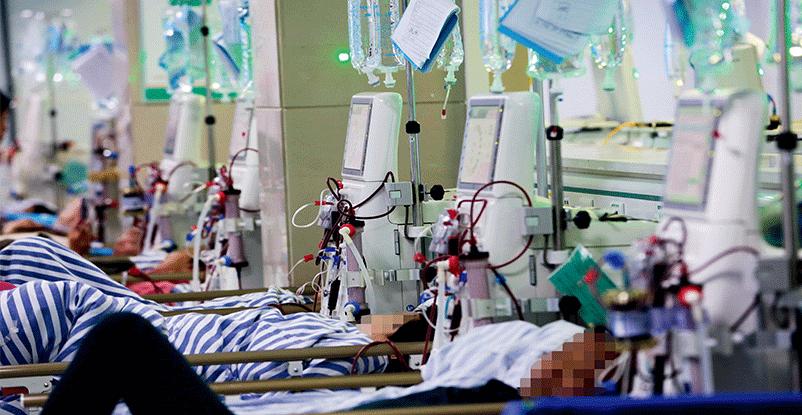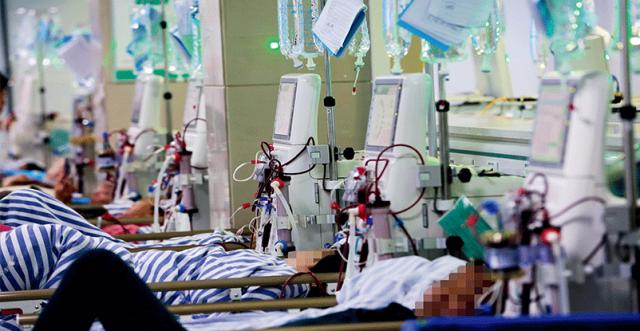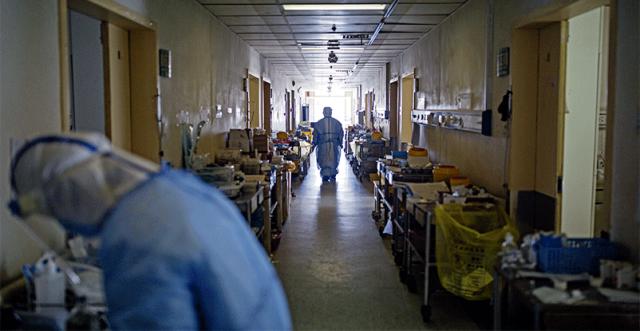On the same day Zhang left hospital, Wang Dechang, the 56-year-old dialysis patient, was sent to a local hotel for quarantine. He was suspected of having Covid-19 following a CT scan.
What troubled Wang was his hospital, Wuhan Third Hospital Guanggu Branch, would not admit suspected virus carriers. A doctor told Wang that he would be readmitted once he was confirmed to have the virus, as it was designated for Covid-19 treatment, and if he was clear, he would be transferred to the hospital’s Shouyi Branch, a non-Covid-19-designated hospital.
But there was no hospital designated for suspected patients like Wang. Although Wang Dechang’s son Wang Lang believed that the majority of patients on dialysis would develop lung problems as a side effect of their treatment, a doctor from the Shouyi Branch told him that no hospital could confirm by a CT scan that the inflammation was definitely not due to Covid-19, so they were at risk of cross-infection.
Wang senior then had two reagent tests, both showing negative. But considering the error rate, he was not removed from the list of the suspected. According to Wang Lang, many dialysis patients in Wuhan were suspected to carry the coronavirus.
Wang’s son tried district-level hospitals, but all were either full or refused suspected patients. Transferring his father to a hospital out of his district was even more difficult, since this came under the municipal command center for epidemic control.
“The policies [related to non-Covid-19 patients] vary between districts, since it depends on medical resources and the deployment efficiency of each district,” Wang Lang told NewsChina.
Other non-Covid-19 patients, who refused to reveal their names, agreed with Wang Lang’s account. They told NewsChina that the policies on non-Covid-19 patients changed frequently and they had no way to get the latest information except for constantly calling district departments and health commissions at different levels.
Zhang Yifei said he has made so many calls, the operator recognizes his voice. An official from Wuhan Municipal Health Commission called him on February 19, but even that official was not sure which hospital could admit Zhang. When Zhang asked if his department could help arrange for a car to take Zhang to a hospital that was far away, he refused.
Thanks to Wang junior’s constant calls, his father was sent to a field hospital on February 16. But given such hospitals were built for Covid-19 patients with mild symptoms and Wang senior was not confirmed as infected, his wife raised fears about cross-infection. Three hours later, Wang was crammed into a big box in the trunk of a car and transferred to another hotel for quarantine.
On the morning of February 19, community representatives from Wang Dechang’s residence suddenly came to send him and two other patients back to the Guanggu Branch Hospital, only to find that the hospital still refused suspected patients. As the driver had already left, Wang was stuck at the hospital gate until his family borrowed a tricycle to pick him up.
By February 19, Wang Lang had not had dialysis for six days, putting him in a critical condition, since hyperkalemia, a major symptom of kidney failure, can cause sudden cardiac arrest. He later underwent a dialysis treatment in the emergency room at Guanggu Branch Hospital.
“Considering Guanggu has been admitting confirmed Covid-19 patients, we were reluctant to do dialysis there, but my father’s critical condition did not allow us to care about the risk anymore,” Wang Lang told NewsChina.

 Old Version
Old Version

